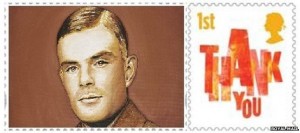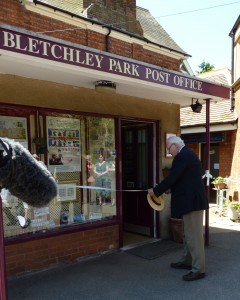ENGLAND –The Web site of a once secret little post office is to close in January 2017. This will be the last chance to view the “little pieces of art and history” produced over 20 years at Bletchley Park celebrating the work of the Alan Turing and the code breakers.
 Originally the undercover mailroom with the secret designation PO Box 111, it became a sub post office in 1947. When Bletchley Park opened as a museum in 1994 it served as a gift shop manned by volunteers. In 2012 it was refurbished and officially opened by the keeper of the Royal Philatelic Collection. It closed in 2015 as a result of changes at Bletchley Park that removed private exhibits.
Originally the undercover mailroom with the secret designation PO Box 111, it became a sub post office in 1947. When Bletchley Park opened as a museum in 1994 it served as a gift shop manned by volunteers. In 2012 it was refurbished and officially opened by the keeper of the Royal Philatelic Collection. It closed in 2015 as a result of changes at Bletchley Park that removed private exhibits.
As well as providing a reconstruction of a Second World War post office and the story of undercover mail it issued special stamps and first day covers. These combined beautiful artwork on handmade envelopes with new stamp issues to tell the story of Bletchley Park. The most popular issues being those for Alan Turing. Some are now worth several hundred pounds GBP and sought after by collectors around the world. The entire collection can be viewed at the bletchleycovers.com Web site.
A brief history of Bletchley Park Post Office
 Around 1900 a small building was added to the side of Bletchley Park mansion to serve as the Butler’s quarters close to the kitchens, cellar and stores.
Around 1900 a small building was added to the side of Bletchley Park mansion to serve as the Butler’s quarters close to the kitchens, cellar and stores.
After Bletchley Park became a top secret code breaking base at the start of World War Two Quartermaster Robert Budd established it as an undercover mailroom in 1940.
Bletchley Park had to be especially careful that letters sent and received did not provide enemy agents with clues about the work it was engaged on. So the mailroom used undercover PO Box numbers such as PO Box 111 Bletchley and routed mail through different locations to avoid revealing Bletchley Park’s real purpose. Everyone had to follow strict rules and censorship when posting mail overseas.
In 1947 the General Post Office (GPO) turned it into a sub post office and shop that continued for nearly 40 years serving delegates attending training courses and oblivious to Bletchley Park’s secret past. The GPO later split to become Royal Mail and British Telecom.
When Bletchley Park opened as a museum in 1994 it became the Park’s first ‘gift shop’ and issued the first of its famous first day covers for new stamp issues. It later began to issue its own customised stamp sheets. It was manned entirely by volunteers.
For many of the thousands of visitors to Bletchley Park it provided an introduction to cover and stamp collecting. Young people in particular discovered the joy of sending a letter or post card bearing one of its special stamps in contrast to texting or email.
In 2005 Bletchley Park Post Office was the guest of the American Philatelic Society at its annual show. In conjunction with America’s National Security Agency and the British Forces Post Office it put on a special exhibit featuring an Enigma machine. A visitor to the show revealed he had a collection of correspondence between a British agent based at Bletchley Park and his German wife, separated when war broke out. They corresponded by letter and telegram until 1945 using the undercover post box number system.
In May 2012 Bletchley Park Post Office completed a refurbishment project with a social history focus to give insight into what life was like as part of the “Home Front”. The refurbishment was opened by Michael Sefi, Keeper of the Royal Philatelic Collection. During his speech he revealed that his father was a senior army officer who during WW2 frequently visited Bletchley Park. The Keeper before Michael Sefi was Sir John Marriot who had been recruited as a Bletchley Park code breaker in 1943. So the links with philately and code breaking have some interesting credentials.











